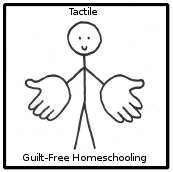Taking the Mystery Out of Learning Styles.
Tactile comes from a Latin word that means to touch, applying here to things that can be learned through touching. The tactile and kinesthetic learning styles have frequently been combined, since touching and moving so often appear together in children’s behavior, but here we will focus on particularly tactile characteristics.
Your tactile learner needs to touch and feel things to learn best. He may not understand a lesson as well from merely reading the material himself or from discussing it with you. If your tactile learner is stumped by a lesson, he will benefit from a 3-dimensional model or manipulatives that he can actually play with and move around, as his fingers provide a direct transmission line for moving information to his brain. He will probably learn more from actually doing a hands-on experiment than he ever would from watching someone else do it as a demonstration.
Try these learning methods with your tactile learner:
- Hands-on experiments
- Craft projects
- Learning aids made from sandpaper and other touchy-feely materials
- Fraction blocks, Cuisenaire RodsTM, and all types of math manipulatives
- When first learning handwriting, allow the student to draw the letters with his fingers in a large pan of dry sand or dry cornmeal before trying it on paper with a pencil
- Allow him to draw, color, or play with modeling clay while you read aloud to him
If you, the teacher, are a tactile learner, you are likely to find a way to use crafts with any lesson. You like to help your students build 3-D models, dioramas, and replicas, and do hands-on experiments.
To reinforce and strengthen tactile skills in your students, try these methods:
- Textured puzzles (such as LauriTM brand)
- Jigsaw puzzles
- Cuisenaire RodsTM and other math manipulatives
- Toothpicks as inexpensive math manipulatives for counting, adding & subtracting, multiplying & dividing
- Sugar cubes as inexpensive math manipulatives for volume, area, multiplying & dividing
- Models & build-it-yourself kits
- ErectorTM sets, Lego’sTM, and other construction toy sets
- Drawing templates & stencils
- Tracing
- Lacing or sewing cards to improve eye-to-hand coordination
- Threading beads onto leather shoelaces or fishing line (again for eye-to-hand coordination); use a variety of bead textures, shapes, and materials
- Gardening
- Board & table games, especially 3-dimensional games such as JengaTM or MousetrapTM [Games can cover all learning styles: you see it, you hear it, you handle it.]
- CraniumTM games come in several varieties and exercise all learning styles
See also:
Tactile Learning
Learning Styles
Auditory Learners
Kinesthetic Learners
Visual Learners
Diagnostic Tools to Help the Homeschooling Parent also includes information on learning styles!

